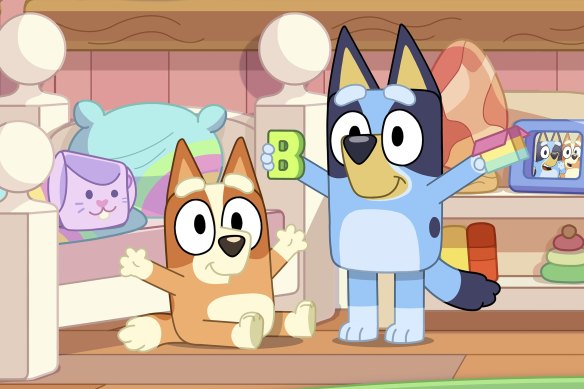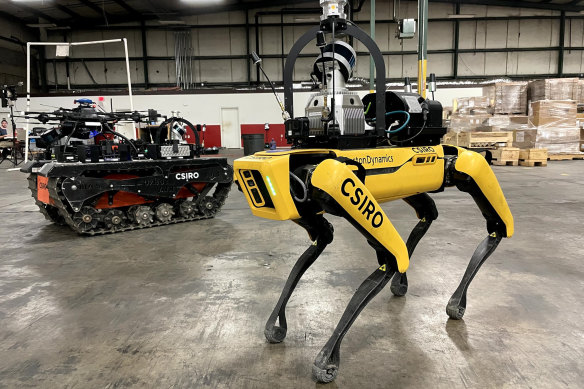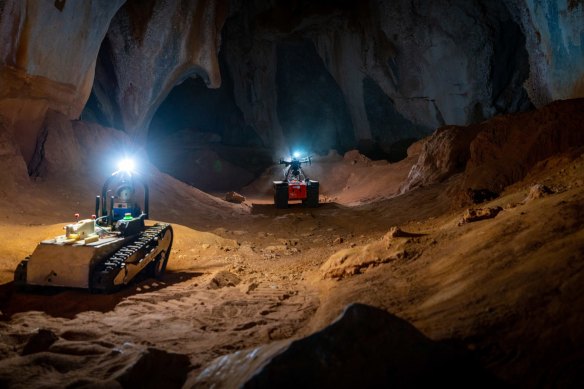This was published 2 years ago
Aussies take podium spot at ‘Robot Olympics’ with help from Bluey
By Stuart Layt
A team of Australian scientists have taken a podium finish at the international “Robot Olympics”, despite not being able to travel to the United States to compete due to the pandemic.
The team, led by scientists from CSIRO, ended up taking second place after tying for first but getting pipped on the tie-break criteria.
The Aussies also took some inspiration from popular ABC children’s show Bluey.

Bluey (right) and Bingo were used as unofficial mascots of the Brisbane-based robotics team competing in the “Robot Olympics” Credit: ABC
CSIRO’s robotics group leader Navinda Kottege said the team were still extraordinarily proud of the result, which was the culmination of over three years of hard work.
“We re so proud of our effort, given the circumstance and given that we were fifth on the leaderboard, fourth and then we ended up beating every team which had beaten us previously,” Dr Kottege said.
US government research agency DARPA (Defense Advanced Research Projects Agency) has been organising the challenges for a number of years, with international robotics groups invited to take part in the three-year cycles of development and competition.
The most recent one, which began in earnest in 2018, saw the CSIRO team as the only Australian-based team to be selected for the competition to develop autonomous robots which could navigate subterranean environments in a search-and-rescue scenario.

One of the CSIRO team’s “dog” robots, named after Bluey characters, with one of the tracked robots developed by Brisbane-based robotics company BIA5.Credit: CSIRO
The teams used “fleets” of multiple autonomous robots to search for markers representing a range of goals including humans, backpacks and mobile phones.
The Australian team was made up of members of CSIRO’s Data61 team, Brisbane-based CSIRO spin-out robotics company Emesent, and colleagues at the Georgia Institute of Technology in the US.
Those latter members of the team became invaluable when the event was put back on this month after being delayed in 2020 due to the pandemic.
Dr Kottege and his colleagues could not travel due to the pandemic, and so had to rely on some of the team from Emesent to travel to the US to link up with their US-based colleagues while the Data61 staff monitored things in real time back in Australia.

The robots doing training exercises in caves in North Queensland in 2020 in preparation for the competition.Credit: CSIRO
He said given that challenge, he is especially proud of his team for achieving equal first, collecting 23 out of the 40 markers which were hidden around the course, although they found the last marker 46 seconds slower than their competing team, a US-based group called CERBERUS, which ultimately cost them top spot.
The CSIRO team used track-wheeled robots, flying drones and two four-legged dog-like robots previously developed by Boston Dynamics.
To give the robots a bit more personality, the team dubbed the two Boston Dynamics dog robots “Bluey” and “Bingo” after the titular character and her sister from the popular ABC children’s cartoon made and set in Brisbane.
“We’re based in Brisbane, so it just made sense to make that Brisbane connection,” he said.
“We also had a third Boston Dynamics dog which we called “Chili” [after the mother on the show] which we kept here in Australia to do diagnostics on.”
After achieving such an impressive result, Dr Kottege said he hoped the robotic advances they had made for the competition could now be adapted for use in real-world scenarios.
In particular, the team developed a unique method for the robots to navigate deep underground without the use of GPS, called SLAM (Simultaneous Localisation and Mapping).
Dr Kottege said that technology in particular showed great promise for advancing autonomous robotics.
“It gives us confidence that we can deploy this sort of technology in the real world and shows the quality of the technology we’ve developed,” he said.